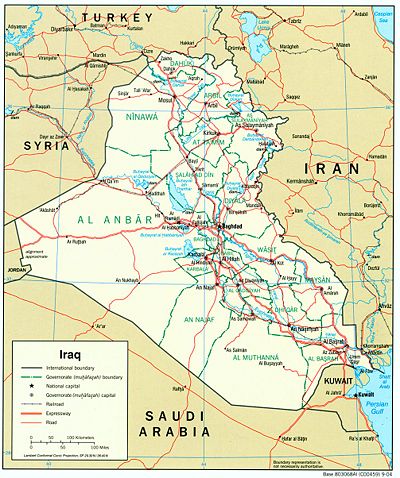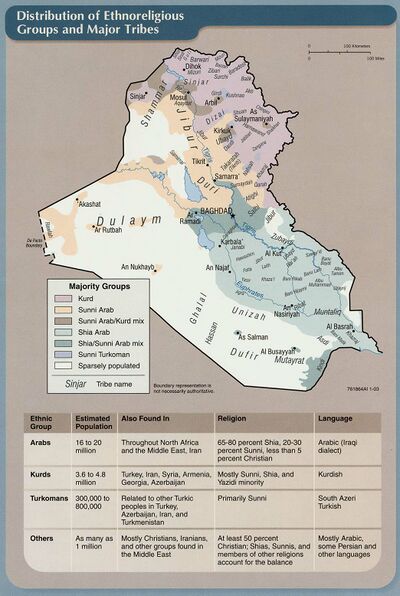Provinces of Iraq: Difference between revisions
imported>Howard C. Berkowitz No edit summary |
imported>Howard C. Berkowitz No edit summary |
||
| Line 1: | Line 1: | ||
{{subpages}} | {{subpages}} | ||
At present, there are 18 '''provinces of Iraq''' and one region. [[Baghdad]]. in [[Baghdad Province]], is the national capital. In formal Iraqi usage, what is called a province is properly a '''governorate''' ((muhafazat, singular - muhafazah) | At present, there are 18 '''provinces of Iraq''' and one region. [[Baghdad]]. in [[Baghdad Province]], is the national capital. In formal Iraqi usage, what is called a province is properly a '''governorate''' ((muhafazat, singular - muhafazah) | ||
[[Image:Administrative divisions of Iraq.jpg| | [[Image:Administrative divisions of Iraq.jpg|left|thumb|400px|Provinces (Governorates) and capitals]] | ||
The country, which was formed by Britain by merging three provinces of the [[Ottoman Empire]], roughly splits into [[Shiite]], [[Sunni]] and [[Kurd|Kurdish]] dominated areas. [[Saddam Hussein]], a nominal Sunni, forced Arabization onto the Kurdish areas, so the population is more mixed there although there is a [[Kurdistan Regional Government]]. Kurdistan also has significant [[Turkmen]] and [[Christian]] minorities; the former a constant area of tension with Turkey. | The country, which was formed by Britain by merging three provinces of the [[Ottoman Empire]], roughly splits into [[Shiite]], [[Sunni]] and [[Kurd|Kurdish]] dominated areas. [[Saddam Hussein]], a nominal Sunni, forced Arabization onto the Kurdish areas, so the population is more mixed there although there is a [[Kurdistan Regional Government]]. Kurdistan also has significant [[Turkmen]] and [[Christian]] minorities; the former a constant area of tension with Turkey. Saddam's former stronghold is known as the [[Sunni Triangle]]. | ||
Most, but not all provinces, have international boundaries. | |||
[[Image:Iraq pol 2004 neighbors.jpg|right|400px|thumb|Iraq with neighbors]] | |||
Many have a formal prefix of al-, as in al-Anbar, but the root part is commonly used. Articles are named for the root (e.g., Anbar) although the table below shows prefixes; there are redirects with the prefix to the articles on the province. | Many have a formal prefix of al-, as in al-Anbar, but the root part is commonly used. Articles are named for the root (e.g., Anbar) although the table below shows prefixes; there are redirects with the prefix to the articles on the province. | ||
| Line 49: | Line 53: | ||
| | | | ||
|} | |} | ||
[[Image:Iraq ethno 2003.jpg|left|thumb|400px|Ethnic geography]] | |||
Revision as of 15:51, 27 July 2009
At present, there are 18 provinces of Iraq and one region. Baghdad. in Baghdad Province, is the national capital. In formal Iraqi usage, what is called a province is properly a governorate ((muhafazat, singular - muhafazah)
The country, which was formed by Britain by merging three provinces of the Ottoman Empire, roughly splits into Shiite, Sunni and Kurdish dominated areas. Saddam Hussein, a nominal Sunni, forced Arabization onto the Kurdish areas, so the population is more mixed there although there is a Kurdistan Regional Government. Kurdistan also has significant Turkmen and Christian minorities; the former a constant area of tension with Turkey. Saddam's former stronghold is known as the Sunni Triangle.
Most, but not all provinces, have international boundaries.
Many have a formal prefix of al-, as in al-Anbar, but the root part is commonly used. Articles are named for the root (e.g., Anbar) although the table below shows prefixes; there are redirects with the prefix to the articles on the province.


